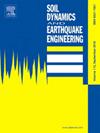Microscopic mechanism of solid-liquid phase transition in sand under cyclic loading: Insights from DEM simulations
IF 4.2
2区 工程技术
Q1 ENGINEERING, GEOLOGICAL
引用次数: 0
Abstract
Under cyclic loading, sand will undergo a solid-liquid phase transition during the liquefaction. This study utilizes discrete element method (DEM) to investigate the stage characteristics of sand macroscopic stress-strain response during the solid-liquid phase transition. The microscopic mechanism of sand solid-liquid phase transition is elucidated from the perspective of contact network. The results indicate that based on the sand flowability, the liquefaction process can be divided into solid phase, solid-liquid transition phase, and liquid phase stages. The strong contact network within the sand is the primary contributor to its effective stress, and the degradation of the originally well-connected strong contact network are the reasons for the sand solid-liquid phase transition. A parameter has been proposed to measure the connectivity of the strong contact network. The weak contacts between particles dominates the sliding and rolling between particles, which is the reason for the macroscopic deformation and flow of sand.
求助全文
约1分钟内获得全文
求助全文
来源期刊

Soil Dynamics and Earthquake Engineering
工程技术-地球科学综合
CiteScore
7.50
自引率
15.00%
发文量
446
审稿时长
8 months
期刊介绍:
The journal aims to encourage and enhance the role of mechanics and other disciplines as they relate to earthquake engineering by providing opportunities for the publication of the work of applied mathematicians, engineers and other applied scientists involved in solving problems closely related to the field of earthquake engineering and geotechnical earthquake engineering.
Emphasis is placed on new concepts and techniques, but case histories will also be published if they enhance the presentation and understanding of new technical concepts.
 求助内容:
求助内容: 应助结果提醒方式:
应助结果提醒方式:


